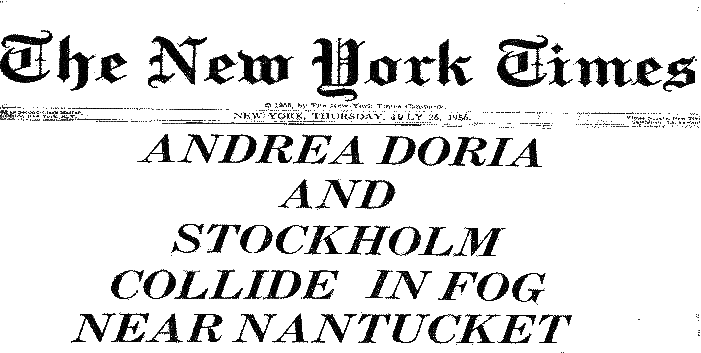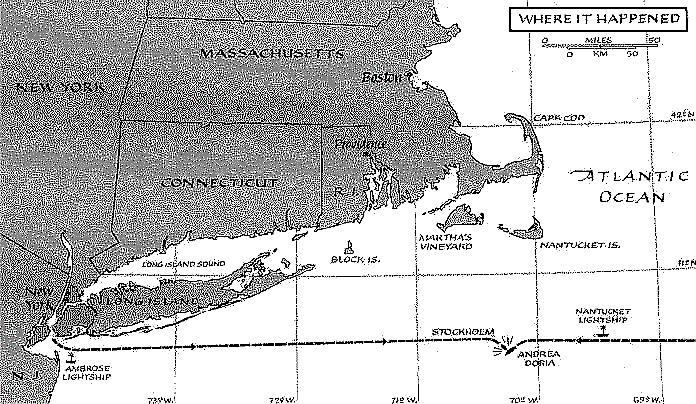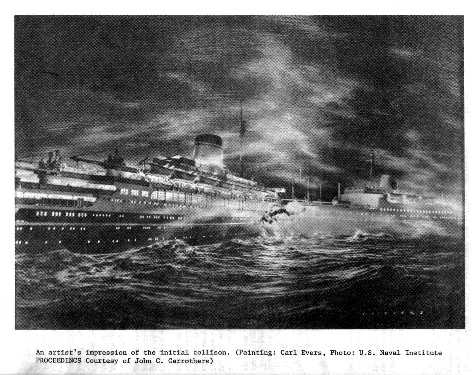

How was it possible that two great ocean liners, manned by experienced crews and having the latest 1950's radar technology, could collide in open waters? Many factors came together in the same instant, sealing the fate of the Andrea Doria.
At 3 p.m. on the afternoon of Wednesday, July 25, 1956, Captain Piero Calamai stood on the bridge of the Andrea Doria, staring to the west. The afternoon sun was headed toward a nebulous haze on the western horizon, the unmistakable precursor of a July fog of the Massachusetts coast.
Fog. The quiet killer of the sea. It enshrouds a ship like a dark blanket, robbing a navigator of his most treasured tool: vision. The Andrea Doria was equipped with two of the latest radar scopes, but Calamai was a traditional captain who preferred the evidence of his eyesight. He would rely on the radar when he had to, but he would keep his own senses vigilant. Fog destroyed more ships than storm winds, coral reefs or icebergs. On this voyage the ship left Genoa on July 17, stopped at Cannes, Naples, and Gibraltar before heading out past the Azores and across a sunny summer route toward New York. She was estimated to arrive at her pier the next morning, Thursday July 26, at 9 a.m.
Like every ship's captain, Calamai had issued standing orders that he was always to be summoned in the event of fog. This Wednesday afternoon he appeared on the bridge before he was called, perhaps sensing an impending haze.The suspicion was based on experience, for the area off Nantucket is often foggy, particularly in July, when the warm currents from the Gulf Stream collide with icy northern waters. A bank of fog stretched ahead of the bow, Calamai called to the engine room to reduce the speed due to fog. The ship slowed from 23 to 21.8 knots.
At its slightly reduced speed the Andrea Doria would reach the Ambrose lightship, the last major checkpoint before New York Harbor, at 7 a.m., only one hour behind schedule. The watertight doors were closed to lock the ship into eleven separate compartments below A deck. The Andrea Doria was "unsinkable" as long as not more than two compartments flooded. The other compartments would stay dry as long as the ship did not list more than twenty degrees to either side.
The ship's foghorn began to bellow its six-second blast every one minute and forty seconds, a necessary but always foreboding symbol of a blinded ship steaming through fog. A seaman was sent up to the forecastle on the tip of the bow to spot an approaching hazard. One of the two Radar units were switched on and checked for proper operation. The Andrea Doria was rigged for fog.
The Stockholm had left pier 97 in New York at 11:31 that morning and by nightfall it was well away from New York, cruising ahead at a top speed of eighteen knots. Nordensen walked on the wings of the bridge in contemplation. Third Officer Carstens went about his duties. He checked the compass in front of the helmsman to make sure he was holding course steady at ninety degrees. He stepped outside the wing and glanced at the crow's nest to assure himself the lookout was alert to his post. He looked for signs of fog and plotted the position of the ship. He also monitored the radar scanner, it was set at the fifteen mile range. At 9:40pm the Captain ordered a change of course to eighty-seven degrees that would take them approximately one mile south of the Nantucket Lightship. A few minutes later Captain Nordensen left Carstens in command and went down to his cabin with instructions that he be notified of fog. The navigation of the ship was now completely in the hands of the third mate, who did not need to be reminded of the standing orders of his stern captain. Never leave the bridge without using the standby sailor as lookout, never pass another ship closer than one mile, and in the event of fog, snow, sleet, or any unusual occurrence he was to put the engine telegraph on standby and notify the captain immediately.
The following sequence was pieced together from the books-Collision Course and Saved. The events as originally reported in the books are in error. A corrected sequence of events has been presented here courtesy of Captain Robert J. Meurn of the United States Merchant Marine Academy based on the findings of John C. Carrothers.

An artist impression of the collision in the fog

